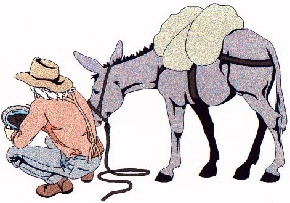 |
| Vol. 7, No. 8 | August 2002 | |
|
Lloyd G. Clements Community Center
7:00 PM (Board Meeting at 6:00 PM)
|
![[GPR Gold Panning Exhibit Booth at Buffalo Bill Days, Golden, Colorado, July 28, 2002]](../../images/goldendemo_020728_b_small.jpg)
Wayne McCarroll at right
in the GPR booth
On Sunday, July 28, 2002, the Gold Prospectors of the Rockies gave gold panning demonstraions during the Buffalo Bill Days in Golden Colorado.
Our kudos go to Wayne Hale for his expertise in setting up and presenting this very well-organized gold panning demonstration. Wayne has spent a lot of time (and some of his own money) putting together a panning exhibitg booth that is easy to put up and to take down. This booth is just another reason why the club has so many requests for demonstrations.
Contact Ken Barker by way of the GPR's contact information.
![[GPR Members demonstrate Gold Panning at the Buffalo Bill Days, Golden, Colorado, July 28, 2002]](../../images/goldendemo_020728_a_small.jpg)
Carl Sauerland and Ed Finney
demonstrate panning techniques
Information gleaned from my recent trip to Alaska - Part 2 of 3
by Carl Sauerland
No event had a greater impact on the later Yukon and Klondike gold rushes than the opening up of the Chilkoot Pass. In 1879, a group of 20 prospectors attempted to cross the Chilkoot Pass into Alaska but the Indians prevented them from climbing the trail. The Indians had the same fears as the Russians, that their Yukon fur trade might be destroyed, if the pass were opened to American gold hunters.
Help came for the prospectors from an unexpected source. the commander of the SS Jamestown sent his naval lieutenant to the pass and the Indians saw first hand how a Gattling gun worked. It must have been an impressive demonstration because on May 29, 1880, the chilkoot Pass was officially opened to white men for the first time. The Chilkoot Pass was in Canada and the Mounties made the gold rushers carry enough provisions to last a season. This entailed climbing the pass for several days, often three or four times a day, until the required amount of supplies was transported.
No one can properly describe the hardships endured by early gold rushers who traveled the Chilkoot Pass. Without necessary supplies, the hungry and exhausted latter-day Argonauts, along with their pack animals, found themselves in a barren, rocky hell, which was later called Dead Horse Trail. the gold rushers beat their horses to keep them moving because once the animals stopped, they would fall to the ground and die. Jack London wrote: "Their hearts turned to stone--those that did not break. And they became beasts, the men on the Dead Horse Trail."
In 1880, Joe Juneau and Dick Harris discovered rich placer deposits in Silver Bow Basin on the southeastern coast. By 1881, the gold rush town of Juneau made its appearance on the map along with thousands of miners who inhabited the town. The Juneau discovery was only mildly productive. Another nearby quartz outcropping discovered by Pierre "French Pete" Erussard became one of the top 10 productive gold mines in the 19th century. Erussard sold out to John Treadwell for a fraction of the gold site's worth. Treadwell was a builder and contractor from San Francisco who formed the Treadwello company to mine the deep lode quartz gold. By the end of the 19th century, the Juneau mines had unearthed over $17 million in gold.
In 1886, some miners struck a rich placer field on a branch of the Forty Mile River, a region that straddled the Alaska/Yukon Territory border. Later, the first interior gold town developed sat Forty Mile in Canada, a mere 25 miles from the Alaska border. It was not a spectacularly rich gold site, but there was enough gold to keep several hundred miners busy for six years.
When the placers looked as if they would soon be exhausted, the mining activity shifted 240 miles away to the Birch Creek area. Out of this small rush grew Circle City. Circle City was the first gold rush town in Alaska's interior. It also was the first to look and feel like a gold rush town with saloons, dance halls, an opera house, prostitutes, and regular steamboat service to the Yukon. It was the Circle City miners who gave rise to the myth of the well-read gold rusher. It began with a U.S. senator who visited the town to see how the miners lived. He was in a miner's cabin when he noticed that it contained a small library. There were books on science, technology, Shakespeare, and six volumes of Gibbon. Back in San Francisco, the senator wrote an article about his trip and indicated that he asked the miner "Who left the books?" "Why, no one. I take 'em everywhere, and read 'em nearly every night when I get time. I'll bet I know more about Caesar, Hadrian, Attila, and all the others than you do, or most anyone else."
Late in 1896, gold was discovered on the Klondike, a tributary of the upper Yukon in Cananda. An experienced prospector by the name of Bob Henderson originally found gold at Rabbit Creek, which later became known as Bonanza Creek. Henderson hated Indians, and the first person he told about the discovery was George Carmack, not realizing that he had a Siwash Indian wife. Henderson was duped out of his rightful ownership of the discovery by Carmack, Carmack's brother-in-law Skookim Jim, and Skookum Jim's friend Tagish Charley. According to Skookum Jim, the trio had been out hunting and Carmack fell asleep under a tree. The Siwash took Carmack's frying pan down to the creek to wash it and got this notion that it might be an interesting place to pan. In no time at all, Skookum Jim had panned about $4-worth of gold. This was considered good in the Yukon where 10 cents a pan was the norm.
At first, many of the old hands at Circle City and Forty Mile refused to believe any version of the gold strike this trio had found. They had all heard it before. Shopkeeper Joseph LaDue, the man who had grubstaked Henderson, heard the news that the strike was where he thought Henderson had gone to prospect and immediately laid out the town site for Dawson City (he knew how money was made). Soon, large quantitites of gold started showing up in Circle City and the gold rush was on.
This time, fate was kind to most of the original finders. Tagish Charley sold out in 1901 and opened a restaurant in Carcross. As owner of a fine establishment, he allowed himself to drink in excess and one drunken night fell off a bridge and drowned. Skookum Jim earned $90,000 a year from his share of the claims and kept prospecting. Some say he died from overwork in 1916. Bob Carmack became a millionaire, left hsi Siwash Indian wife, remarried, and settled down in Vancouver. At the time of his death in 1922 he owned another mine in California, an apartment house, and a hotel. Henderson was recognized by the Canadian government as the rightful discoverer of the Klondike gold and given $200 a month pension. He never made any other money from his claims and died a broken man.
It was another slow start to the rush because the rest of the world was even more skeptical than the miners in Circle City. By July 1897, there were only 4,000 gold rushers in the Klondike. The real excitement came when two steamers arrived in Seattle and San Francisco carrying gold valued at $1.5 million. That was proof enought for even the most hardheaded. Newspaper headlines screamed about the "inexhaustible Riches of the Northern El Dorado," anmd some hundred thousand men and women started out for the North to reap its riches. Dawson City was the goal. About 40,000 Argonauts made it there and another 10,000 ended up in Alaska.
Mining was done at the early Caslifornia level of technology, with a few necessary gold-weather twists. The bedrock where the gold lay was anywhere between 20 and 200 feet underground. In order to penetrate the permafrost, miners had to burn out a shaft with wood fires. The back-breaking process of thawing, digging out the dirt, and thawing again, finally led to the bedrock. The gold-bearing gravel then had to be hoisted out of the hole in buckets and stored in large piles until Summer. With the warmer weather came the water needed to process the gravel in pans and sluices. It was not a lot of fun, but it was profitable. From
From 1897 to 1900, $50 million in gold was mined in the Klondike. With so many gold rushers in the region, it was inevitable that gold would be discovered somewhere else. But that's another story (to be continued in the next issue).
|
|
|
| Wednesday, July 17, 2002 | |
| 3.5 gram nugget - | Dan Fling |
| 1.0 gram nugget - | Barrett Palumbo |
| 0.8 gram nugget - | Donovan Greene |
| 0.7 gram nugget - | Glen Godat |
| 0.8 gram nugget - | Fritz Meyer |
| 0.7 gram nugget - | Doug Taylor |
| 0.7 gram nugget - | Fritz Meyer |
| 0.8 gram nugget - | Joe Shubert |
| 0.7 gram nugget - | Barrett Palumbo |
| 1.4 gram nugget - | Glen Godat/Donna Mosteller |
| 0.8 gram nugget - | Roger Woodhead |
| 0.7 gram nugget - | Barrett Palumbo |
|
|
|
| 0.7 gram nugget - | Larry Armstrong Aussie nugget donated by Randy Solomon |
| 0.4 gram nugget - | Ken Barker Mexican nugget onated by Randy Solomon |
|
|
Wet Suit For Sale
|
Members: Your Ad Could Be Here
|
|
|
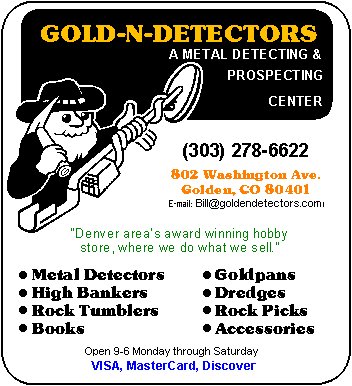
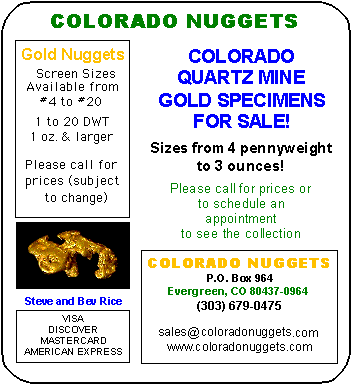

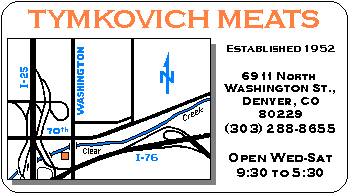
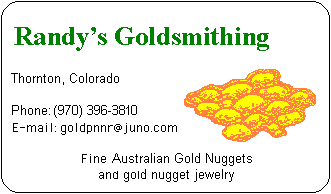

|
is an official publication of the Gold Prospectors of the Rockies, a Denver-based, Colorado nonprofit organization established in 1995 for the enjoyment of gold prospecting and metal detecting. Club meetings are held on the third Wednesday of each month, 7:00 PM, at the Lloyd G. Clements Community Center, 1580 Yarrow Street, Lakewood, Colorado (1 block west of Wadsworth, 1 block north of Colfax). Individual or family membership fees are $30.00 for the first year, $25.00 for each subsequent year. Non-commercial business-card-sized classified text ads for members are free of charge. Commercial display ads must be detecting, prospecting, or treasure related and are available to anyone at a modest charge: 1/8 page (approximately 2"h x 3.5"w business card size) - $6.00 per month. 1/4 page (approximately 4"h x 3.5"w) - $12.00 per month. 1/2 page (approximately 4"h x 7"w or 8.5"h x 3.5"w) - $24.00 per month. Full page (approximately 8.5"h x 7"w) - $48.00 per month. The Gold Nugget is open to and gladly accepts submission of information and articles. All article submissions must be received by the editor no later than the first Wednesday of the month for inclusion in the next month's issue. The GPR must receive any required payments for commercial ads prior to their inclusion. Include publication information on articles clipped from other publications. The Editor reserves the right to edit all submissions. Bulletin editors may print any article from this newsletter with credit given to the newsletter and the author. Contact: The Gold Nugget Editor, The Gold Prospectors of the Rockies, PO Box 621988, Littleton, CO 80162-1988. E-mail: The Gold Nugget Editor. |